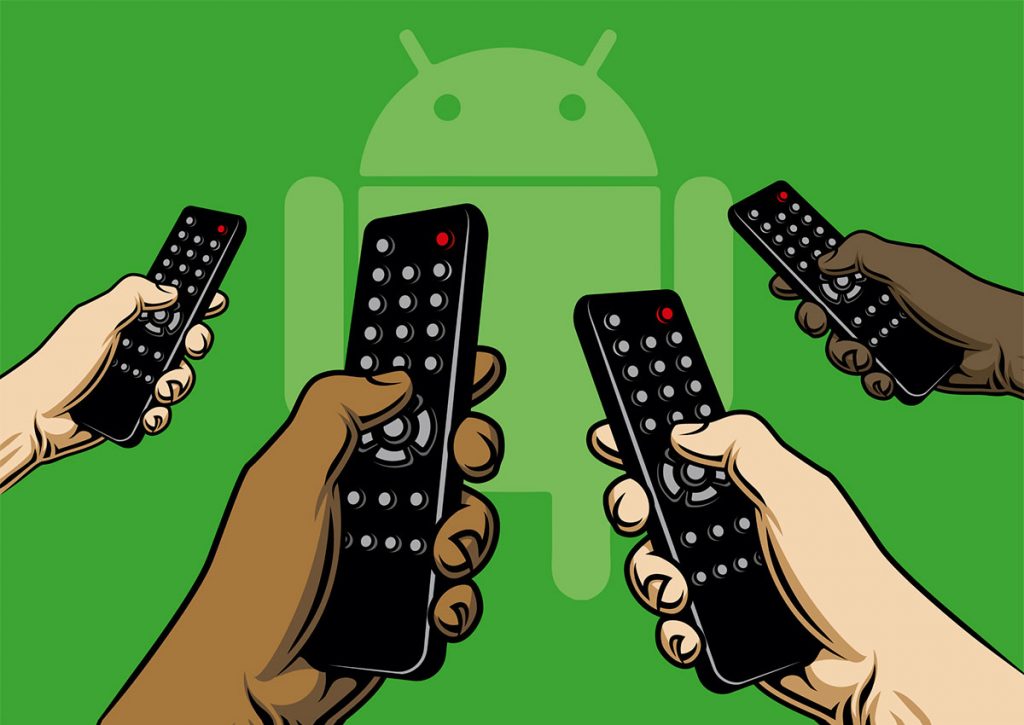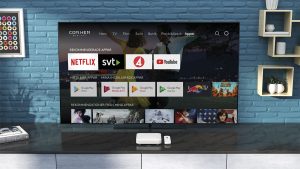Onwards for Android
 The rise of Android TV as the operating system of choice for an ever-growing range of service providers speaks to the realisation that aggregation of multiple app-based video services and a compelling user experience are the key competitive tools for operators. Stuart Thomson reports.
The rise of Android TV as the operating system of choice for an ever-growing range of service providers speaks to the realisation that aggregation of multiple app-based video services and a compelling user experience are the key competitive tools for operators. Stuart Thomson reports.
The Android TV Operator Tier platform has gained numerous adherents among service providers over the past year or so, giving rise to a sense that Google’s TV operating system now has unstoppable momentum. That at least is the case among telecom operators that primarily look at TV as an essential part of the multi-play bundle and see the future of video as app-based and open.
As streaming services have gained in popularity at the expense of traditional pay TV, multi-play operators have become more focused on marketing those multi-play services while providing access to multiple OTT offerings to their customers via the set-top box.
The Android TV Operator Tier matches the needs of many operators because it takes much of the development work to create an advanced TV service out of the operator’s hands. Compared with the Android TV retail platform it gives operators additional flexibility to create their own user interface and surface their own content first in search results. Above all, it works for operators because it gives access to the Google Play store with its plethora of content offerings. Other key features that appeal to service providers include the fact that the Google’s market power and scale means that they can tap advanced high-power set-tops that are cheaper because they are deployed at scale. It also gives them access to Google Assistant and voice-based search.
For a growing number of service providers, Android TV matches their needs by enabling them to provide, instantly, a broad range of on-demand apps within a user experience that is recognisably their own.
User experience
Swedish cable operator Com Hem, now owned by Tele2, has been live with Android TV for about a year across both its cable TV service and its Boxer-branded digital-terrestrial service. The company initially targeted its premium subscribers along with those customers that used a conditional access module rather than a set-top and did not have access to advanced services. The initial focus was also on subscribers that did not have a DVR service, although Tele2 is looking to introduce DVR as part of its Android TV offering in the future. The operator launched with an advanced box capable of addressing its entire base.
“We saw several advantages. Product-wise it enabled us to own the UI and the UX,” says Jessica Andersson, head of TV product at Tele2, who adds that adopting Android TV was cost efficient, enabling the operator to avoid devoting resources to working on a TV platform itself as well as offering frequent updates.
“Having Operator Tier does require you to do more of your own development but having your own UI and the ability to integrate other apps like Netflix into that UI has been a huge advantage,” she said. Andersson says that “owning the UI” and having customers land on its own branded area rather than being one of a number of apps was a major attraction, along with the ability to deliver a unified customer experience across all platforms.
Com Hem also offers its TV service on retail devices in the form of Com Hem Play, which is available on other devices such as Apple TV as well as Android devices. Andersson says that the company will “go more and more in that direction in the future and become less dependent on set-tops and infrastructure”.
“We are already preparing for that shift. We really see this as a bridge to a boxless world,” she says. Nevertheless, this is not a shift that Com Hem will make in the near future, for the same reasons as many other operators, including the fact that older subscribers are more comfortable with set-tops than with newfangled apps and the fact that the box servers as a point of aggregation of a range of other services that carries the operator’s own brand. “I think it plays a role,” she says. “Specifically, it plays a role in aggregating content and Android TV enables you to merge SVOD services as well as other content. Being able to deliver this to multiple devices is something that Android really supports.”
Andersson says that Tele2 aims to tap Google’s voice search capability as soon as Google Assistant is available in Swedish, something that is expected for Android TV soon, and to build its own UI to give its own content a privileged position in order to promote specific services and content.
Competitive markets
For mid-sized operators in competitive markets, Android TV makes perfect sense. South-East Europe-based United Group, owner of Serbian cable operator SBB and a number of networks across ex-Yugoslavia states including Slovenia and Bosnia-Herzegovina, deployed its Android-based service last October using the Operator set-top mode but with the Android TV native launcher rather than a custom launcher.
Srđan Đurđević, R&D director at United Group, says that the company opted to use the default Android TV native launcher to start with in order to get its service up and running as quickly as possible.
“Our idea was to be fast to market and that’s why we used their native launcher,” he says. Đurđević says that the group is mulling migrating to an Operator Tier launcher that it could develop from its own internal resources. However, he says the basic launcher has proved “good enough” to enable a differentiated service. “Our UX team did a nice job to connect their home page with our home page with call to action buttons and a branded background,” he says.
One of the main attractions of the platform he says, was the scope it offered to layer additional services on top, including the Google Play Store, Google Cast, YouTube and gaming apps.
“The same is happening on TV as has happened in the mobile business where everything is app-based. Now we have smart boxes and app-based TV is already part of Android. With this type of box we can control HDMI1 on the TV and become the aggregator of entertainment services,” he says.
Đurđević says that United Group installed some 50,000 boxes in the first three months after launching the platform. The operator is now moving on to the next stage of its Android story by developing devices to complement its EON advanced hybrid set-tops.
“We have a very aggressive roadmap and we are developing new Android TV set-tops and dongles and so on. Our idea is to develop more operator devices that support the EON-based Android TV ecosystem, and then develop more services,” he says.
While the initial EON box is a hybrid device that allows the operator to provision it for IP or DVB reception or both remotely, United Group is now planning to launch ha pure OTT box and a dongle that does the same job with an eye to a future that “is all IP-based”.
Đurđević says that United Group is also interested in the potential of delivering its services direct via smart TVs, but the business case for this is still to be worked out in a market characterised by low average revenue per user.
For the foreseeable future, however, these all-IP devices are designed to complement rather than replace the hybrid model.
“In the cable world DVB-C is an advantage for us compared with pure IP providers because we can connect any TV in the home inexpensively and older people for sure will need DVB,” says Đurđević.
The flexible combination of access to Google Play apps with over-the-air TV channels appeals both to established operators with legacy TV bases and to those seeking to break in as disrupters – examples of the latter include Wind
Hellas, the Greek telco that launched an Android TV-based offering, in this case with a custom launcher provided by Zappware, and which was able to use its ability to deliver Netflix as a key element in a highly successful marketing campaign
Flexibilty
Android TV – both in its Operator Tier and Google UI iterations – now offers a greater degree of flexibility than was the case when Google initially set its sites on the TV market.
Chris Thun, vice-president of product at TV technology provider TiVo, which recently participated on a webinar on this topic produced by Digital TV Europe, says that Android TV Operator Tier “really gives the operators a significant degree of control back where they own the branding and the user experience in return for building into their own experience a few of the things that are really important to Google” such as Google Assistant and rules around surfacing the apps in the Google Play store. “Beyond Operator Tier the Android TV team has also made a lot of progress in security and clarifying the reality around data ownership,” he adds.
“The real draw is the pay TV industry recognises the value of embracing a platform approach, especially with the world of pay TV and OTT converging. It doesn’t make sense to think about monolithic middleware as a path to market. Android TV represents a really viable platform approach for the industry to converge around,” says Thun.
While the main initial appeal of Android TV Operator Tier has been to mid- and small-sized operators, Kai Christian Borchers, CEO of technology outfit 3 Screen Solutions (3SS), which has been heavily involved in getting Android TV Operator Tier service providers up and running, says that larger players are now taking an interest.
“Up to now the operators that were looking at Android TV in general were operators that had somewhere below two million subscribers. What we are seeing now is that the bigger operators are starting to take an interest,” says Borchers.
Google recently revealed that there were 140 Android TV projects of all flavours up and running or in the works this year, with 40 services now live.
Borchers says that the main pull of Android TV Operator Tier is the Google Play Store. The older Android Open Source Project (AOSP), which he describes as “now technically a clone of Android TV” is, says Borchers, being seriously evaluated by some larger players that want to do more of the work of setting up a TV service in-house.
Whereas in the early days of AOSP, operators had to do most of the work of building the TV service themselves, they now have a access to all of the technical features of Android TV but without the Google Play Store, meaning that operators that go down this route will likely tap an app store provider such as Metrological or Vewd to deploy a service.
Borchers says that operators choosing to go down the Operator Tier route now find that Google is increasingly working towards operators’ specific requirements, such as enabling them to give prominence to their own search results rather than those that Google turns up.
Ivan Verbesselt, senior vice-president of marketing at TV technology outfit Nagra, agrees that Android TV of all flavours has “momentum” and says that this is primarily because Google “listened to what operators wanted and created something more flexible”.
Verbesselt says that not all operators will want to be tied as closely to Google as the Android TV Operator Tier still requires and some of these may choose to adopt the AOSP. “They don’t get all the apps but they are in control of their own destiny,” he says.
There are other advantages. Pre-integration of conditional access by the likes of Nagra means that operators can take advantage of off-the-shelf set-top boxes to deploy service in a much shorter time than is possible with Linux devices.
Challenges
Many of the operators that adopt Android TV will tap the services of a custom launch provider or do additional work in-house to develop a functioning user interface and other features that Google does not support, such as DVR. New features introduced with Google Assistant need to be matched with a front-end experience.
“DVR is so highly proprietary and there are so many country-specific rules that you have to follow – can you do local or network DVR, how many parallel streams can you record, can you record pay TV services? Also, what kind of stream to do you want to record – DVB, IPTV, OTT? This is something Google doesn’t want to be bothered with,” says Borchers.
Borchers says that 3SS has a launcher that works with hybrid deployments – something else that many operators want – whether that means OTT plus DVB or OTT plus multicast IPTV. Pure OTT deployments, says Borchers, typically are targeted to niche markets such as subscribers’ second homes or for multiroom applications, or to deliver a skinny-bundle service off-net.
Hybrid deployments seem likely to be the rule for most operators, whether they have launched a service already or not.
Mikolaj Zapala, senior director, strategic accounts at TiVo says that his company has also “seen a rise of interest” in hybrid platforms in various combination, particularly among operators that “have significant [numbers of] boxes in the field”. The challenge facing operators with legacy deployments, he says, is how to transition to Android TV without duplicating back-end infrastructure.
The question of how close operators can get to Google without starting to feel uncomfortable is one that has been aired frequently at industry conferences over the last couple of years. Operators that use Google Assistant are opened up to the possibility that Google could gather and use data from its operator customer base, although it says it is not doing this.
Tor Helge Kristiansen, vice-president of technology at Nagra, also points to what he sees as a certain lack of clarity about how long Google will continue to support a given generation of set-top boxes with updates before introducing updates that leave older boxes behind.
For Tele2’s Andersson, from an operator perspective, “in the short term, the biggest concern is about software stability and being able to transition when there are new updates” rather than big questions about who controls data, “but on a long term basis it’s something we keep a close eye on and also still have concerns over”.
For TiVo’s Zapala, Google’s efforts to “clarify what it is collecting, what it is viewing and what it is and isn’t able to access” has gone a long way to assuage operator concerns about data.
United Group’s Đurđević likewise is unconcerned about control of data, and argues that Android TV is simply more beneficial for the service provider than the cable operator alternative of RDK. The latter requires that operators develop their own app store or use that of a third party such as Metrological, which lacks the universality of Google Play.
Đurđević says that the main “challenge” facing his company is how to keep up with updates in the Android TV operating system. Đurđević is less concerned about ongoing support for legacy set-tops, pointing out that operators will be able to continue to use boxes beyond the point where Google is willing to upgrade them to the latest version of the platform.
While the commercial arrangements between Google and operators are still “not completely adapted to what we as operators want to do”, Đurđević believes that “this will probably come soon”, and Google has instituted a carrier billing programme for operators that want to add Google Play apps to subscribers’ monthly payments.
Regarding the lack of support for DVR, he says that United Group is now wholly focused on a cloud DVR model, but has yet to launch.
Evolution of TV
While DVR can be seen as a legacy product, at least in its set-top box-based form, one of the major attractions of Android TV is that Google is seen as a company that is helping define the future of consumer technology, and that brand perception is important to its service provider partners as well.
It is no surprise then that operators that adopt Android TV have in general keen to deploy Google Assistant.
“Voice interaction has now entered the mainstream,” says TiVo’s Thun, who adds that “voice offers major opportunities to simplify the UX going beyond command and control, involving natural language understanding” and points to a future of “highly personalised, highly conversational interfaces”.
There are some caveats. 3SS’s Borchers admits that the lack of language support is “a bit of an issue” in the way of operators in some territories signing up for Google Assistant.
Even in countries where there is language support, some larger players such as Orange have their own smart home strategy and have developed their own voice-enabled assistant as part of that drive, and in these cases signing up with Google may be less attractive – although in the case of Orange, that company’s Spanish operating unit has adopted Android TV as part of its battle with larger players such as Telefónica and Vodafone.
Not every operator is interested in jumping on the Google Assistant bandwagon, or at least not yet. United Group’s Đurđević says that his company doesn’t currently see much mileage in adopting the platform because of the lack of local language support and because such technology is not currently “a must in our region”. However, he says, as the market evolves and the group’s TV customer base becomes familiar with this type of technology, United Group will introduce voice control as a. matter of course.
For many small to mid-sized operators in particular, the integration of Google Assistant is also a huge benefit, particularly as Google is willing to let operators privilege their own content in search results. It also gives them a key building block in a smart home play.
“Part of the value of Google Assistant is that you can control not only the TV but enable it as the control centre for the home,” says Nagra’s Kristiansen.
Voice search via Google Assistant – and Android TV in general – is a part of what Nagra’s Verbesselt describes as the bigger picture of “client horizontalisation”, with Android boxes joining their place in a line-up of native IP devices that includes Roku, Amazon Fire and Apple TV.
‘Client horizontalisation’ goes hand in hand with ‘service virtualisation’, meaning migration of the service provider headend to the cloud. In this telling, back-end platforms of the type offered by Nagra under its OpenTV brand and multi-device security will unify an offering that is essentially device-agnostic. Local OTT TV providers will be encouraged to sign up with local service providers rather than to strike out on their own by porting their service to various retail devices.
Getting those OTT TV service on board is the key goal. For infrastructure-based service providers, this enables them to take ownership of the HDMI1 port on the main TV in the living room – something that is emerging as the new Holy Grail for TV operators – as well as servicing consumers’ requirements for multiscreen viewing.
“Keeping people on HDMI1 is beautifully achieved with Android TV,” says Verbesselt. “You have all these pre-integrated apps and YouTube and that is a big upside. And you can cajole local players to integrate.”







